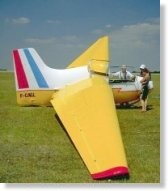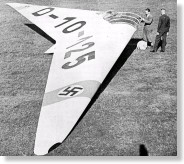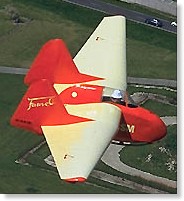Charles
Fauvel is best known in aeronautical circles as the designer of "flying
wing" type gliders. Yet his life was equally rich in many other events
which marked the development of French soaring, and which we will evoke
throughout this biography.
| Still in 1928, toward the end of the year, Charles Fauvel put the finishing touches of a small light single-seater, the Peyret-Mauboussin PM-10, equipped with a 34 hp Scorpion ABC engine, whose best glide ratio was nearly 16 without engine fairing or wheel pants. It was with this machine that he beat, in September 1929, several international records in the under-400 kg category, including the international altitude record (5,193 meters) and the duration record (12 hours). In 1929, Fauvel participated in the creation of AVIA with Massenet, Auger and a few friends; this was a committee founded to promote the development of soaring. He then left the air force to join AVIA as sport director, while remaining chief pilot of the CAU. He prospected and discovered the airfields of Beynes (near Paris) and of la Banne d'Ordanche (in Auvergne). In the same period he received and perfected the single-seat AVIA 10 A designed by Jarlaud at the Béchereau works. In 1931, he had to leave AVIA, which was suffering financial difficulties, and re-enter the Air Force as a test pilot at the Villacoublay flight test center, until 1933. While on leave, he participated in the Vauville competition in 1931 in the AVIA 32 E, and managed the best French distance of the competition. In 1932, he passed his C license (no. 19) at la Banne d'Ordanche, on the AVIA 15 A. | ||
| In 1954, Charles Fauvel
started his own enterprise, the SURVOL company,
at Cannes, whose purpose was to promote and
facilitate the commercialization of his flying
wings. In 1956, it was the two-seat AV-22's turn
to see the light of day; six of these machines
were built. It is often considered Charles
Fauvel's masterpiece, and marks the consecration
of his two-seat flying wing glider designs. In
1958 he instituted the Survol Cup to reward the
best-performing AV-36s, and later AV-22s. In May 1960, Fauvel made the first flight in René Fournier's RF-1, a "glider/airplane" whose descendants (RF-3, RF-5, RF-10...) were to fly in many countries. Interested in the motor-glider concept, with its freedom from the constraints of towing and winching, he brought out his AV-45 in 1960, equipped with a Nelson 37 hp engine, later improved under the designation AV-451. These models had scarcely any success, no more than the AV-221 which was officially presented at the 18th assembly of amateur builders at Montluçon in 1965. Extrapolated from the AV-22, the AV-221 was a side-by-side two-seater with a Rectimo 39 hp engine. Despite its good qualities, this flying wing, reduced to a version - AV-222 - for amateur construction, was unable to make inroads in the market. The fashion of that day was high-performance machines, and the motor-glider formula - even in conventional configuration - could not get good press in France. |
 |
AV-22 |
|
| In 1971, Charles Fauvel
decided to stop commercial production of his
gliders, but continued to distribute stacks of
drawings to amateur builders. The Survol company
offered the AV-361, the AV-451, as well as
touring craft such as the AV-60. From 1972 on he
was president of the Fayence soaring center and
also participated in the OSTIV (Organisation
Scientifique et Technique du Vol à Voile)
congresses, notably in 1978 at Chateauroux, where
he presented his report on the flying wing design
formula. He died on 10 September 1979 at the
controls of his airplane, a Gardan "Super
Cab", which struck the Alps at 735 meters
altitude north of Genoa, in Italy. Recipient of the Croix de Guerre 40-45, Officer of the Legion of Honor, Médaille d'Outre-mer (Overseas Medal) 1926-1927, Aeronautical Medal, Grand Silver Medal of the Aéro-club de France, Grand Gold Medal of the FFVV, Charles Fauvel flew more than 200 different types of airplane and 50 types of glider. The small means available to him, both technically and financially, prevented him from advancing his ideas as far as he would have liked. Prejudice and fashion both worked against him, but he remains undoubtedly one of the most prolific and inventive french engineer-pilots. Certain recent projects, like the American Genesis glider, tend to prove that current computing methods allow the construction of high-performance gliders equipped with inherently stable wings. Furthermore, the recent resurgence in interest in light motor-gliders shows that there, too, Charles Fauvel was a pioneer, and that his work must not be allowed to sink into obscurity Translated
from the French by Marc de Piolenc (piolenc@reporters.net). |
|




